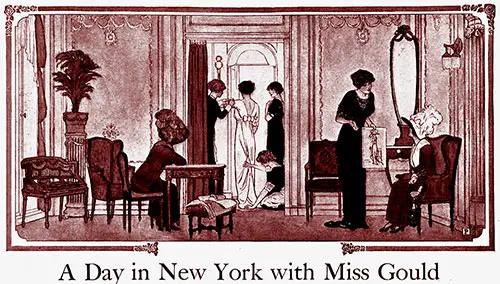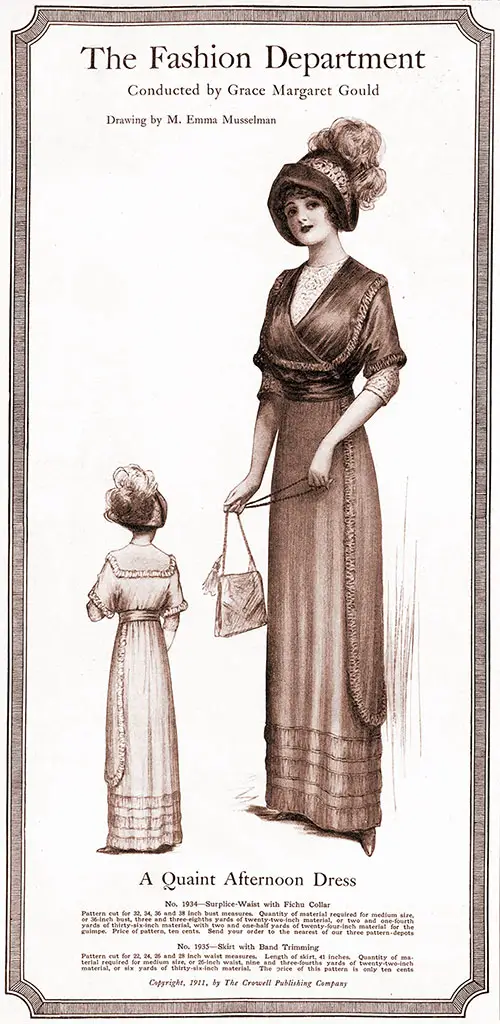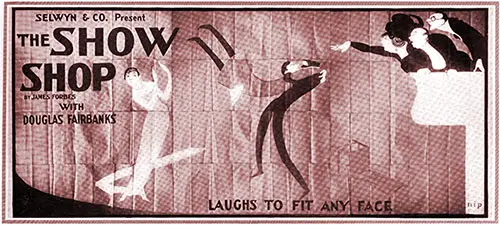A Day of Dress Fashions in New York with Miss Gould - 1912

In which You See the New Fashions at a Smart Modiste’s, and on Fifth Avenue at Afternoon Tea and the Theater
I am taking it for granted that all my good friends who read the Woman’s Home Companion do not know New York and love it as I do. After all, the home instinct is strong in all of us, and I am glad it is.
However, New York is the place of all places to see things. It is the emporium, the art gallery, the department store, and, outside of Paris, the dressmaking establishment of the world. It is a universal exhibit, and it is worth seeing: the lure, the charm, of it is proverbial.
It is for this reason that I thought you might enjoy going about with me for a day and seeing New York as I see it. For us who are interested in dress, New York offers an infinite variety of models and modes. If the proper study of woman is women, then here, above all other places, is the one place to study them, and especially their clothes. I want you to feel you are with me on a glad spring day when New York is its fairest.
We will take a close look at the styles in one of the big, fashionable dressmaking establishments; we will walk together on the Avenue, have our cup of five-o'clock tea at the smartest of New York's restaurants, and later go to the theater. Now isn't that a rather interesting plan.
At a Fashionable Dressmaking Establishment
I am sure if you have never been inside one of these very fashionable New York dressmaking establishments, you are going to enjoy our first call. Well, it is eleven o'clock when we step into the most exquisite of drawing-rooms, in a house just off Fifth Avenue. It is hard to believe it is not a private home of one of New York's society leaders.
What could be lovelier than this color scheme of exquisite French gray, the velvet carpet and silken draperies matching in tone? Just see these chairs of gray and silver; and the chandeliers of silver, too, with the lights gleaming through rose-silken shades. Artistic, isn't it?
The head of this establishment would impress you as a fashion-plate, so lithe and straight is her figure, so elegant her costume, if she were not at the same time so much of an artist and so gracious a woman. She is tact itself. She will not mind in the least if we draw our chairs together and watch for a while just how she conducts her most interesting business. It is a far cry from the old experience of going to the dressmakers to come into this most fashionable establishment.
Now, see this woman Madame L. is just greeting. She is a new customer. Does she have to stand up for a tedious length of time and have her measures taken? Not a bit of it. Madame talks to her about the new fashions in general and about one frock in particular. She hardly gives her customer a chance to say she will order it, when, like magic, the pattern woman arrives.
This woman, let me tell you, has nothing to do with paper patterns. Do you see that roll of cambric she has in her hand and the pincushion that is fastened to her side? Well, you watch the way she uses her scissors and her fingers, and before you know it, you will see that she has fitted the cambric to the customer so that she has a perfect model of her figure in cambric. I think it is perfectly wonderful the way she does it.
See, there she goes back to the workroom. Now let's see what comes next. Did you hear Madame L. say she would try to make it for $250? My goodness! I wonder if she considers that cheap.
Seated on that little French divan over there, is another of Madame L.'s customers. She is here for her first fitting. I know, because I heard her give her order the other day for a chameleon taffeta dinner gown. I wish Madame L. would let us go in the little dressing room. It looks like a bit of a jewel-box, all silver and rose and gray; but I don’t like to ask her, so let us just watch.
See that very pretty girl? Well, she has just laid the sheet down on the floor, and it is her duty to help the customer off with her frock. Then that woman who is just coming in the room is the waist-fitter, and the younger girl behind her doesn't do a single thing but attend to the fitting and the proper adjustment of the sleeves. Wouldn't you think one woman would be all they would need to fit waists, But Madame L. prides herself on her artistic sleeves, and so she wants a specialist for them. I am awfully sorry they have drawn that silken curtain. I did so want you to have a glimpse of the waist, but, you see, Madame L. is in there now criticizing it. I assure you, not the slightest detail escapes her, and she criticizes the work as if she were judging a painting.
But here comes still another woman. She is the skirt-fitter. Hard, did you say, on the customer, standing up before all these women? Oh, she doesn't mind it, unless it is her first ordeal. Then she is apt to be really shaky in the knees.
But here is Madame L. Let me ask her to talk a little about the spring fashions.
“Yes, Miss Gould, I am making up an unusual number of silk gowns for spring, and these I am not veiling. The new taffetas are just captivating. And they look so quaint and charming combined with old lace. The pussy-willow taffeta I am using a good deal: it is so soft and drapes so beautifully. Yes, everything is shaded for spring, and I am making many dinner gowns of chameleon taffeta, and that exquisite French silk, soie ombrage. That, you know, shades from the lightest tones to the darkest. I am giving very special thought to the backs of my gowns this spring. At one time the back of a gown could be easily neglected, but not so today.
Now both the dressmaker and the customer regard it as most important. Of course, the well-gowned woman must look just as fashionable when she is walking away from you as when she is approaching you, so the importance, you see, of giving the right lines to the back and introducing the right trimmings. By the way, Miss Gould, long sleeves are just pushing themselves into fashion and the majority of my spring gowns are no wider than they have been, but I won't say a word now what I may do next early fall.”
If we only had the time and could just listen to Madame L. for the rest of the day, we would learn all the smartest things about the new fashions; but you must get a glimpse of Fifth Avenue, and this is the time to go in the big shops, for they are not so crowded.
Let's keep our eyes open, so we won't miss anything worth seeing. We will probably meet many a fashionable hat that covers an empty head, but just let me assure you that many of the best-dressed women in New York are at the same time very worth-while women.
Types and Fashions on the Avenue
Now, look at that woman just going in the florist's on the corner. Isn't she stylish?' Her tailored suit, I know to be absolutely correct. That shade of tan worsted with its almost invisible stripe of brown is extremely fashionable this spring. Her coat is short, just as it should be, and it has the right straight line.
And then her skirt—it is narrow, but in no way so extreme that she looks conspicuous. Her close-fitting tan straw hat, with its plaited taffeta ribbon in shades of brown, tan, and green, is exactly in harmony with the type of costume she is wearing. To my mind, she is the tailor-made type correct in every detail. But look at her a bit closer. Just see what a fine, strong face she has, and it is a sweet face, too. Don't you think for a moment that a woman like that is absorbed in just clothes: she is too broad and fine. You can believe that she has many wide and varied interests, but that doesn't mean that she neglects her clothes.
Well, here we are studying types when I promised to show you some of the new fashions and some of the new fads. This store that takes in nearly a whole block on the Avenue is one of the most luxuriously equipped department stores in New York. We must go in for a moment or two.
Did you ever see so many attractive bows? Don't you like those long narrow ones? You see, they are made of black velvet, faced with a bright-colored satin. I think they are stunning: they are so flat and show that bright touch of color so effectively. Then look at this counter where they always have the most irresistible scarfs.
See the new collar-and-cuff sets in the cases! They are odd, aren’t they, those round, flat, linen collars with their curious designs in black embroidery? I never saw such a decided shade of yellow linen, but I can just see how striking they would look on a black cheviot tailored coat or a brown one. And then there are the cuffs, too, and aren't they deep and good-looking?
As for scarfs, I always want to buy everyone I see. You notice the newest are in the bordered effect, and all the new fabrics seem to have borders this spring, too, whether they are of chiffon cloth, ēolienne, or just dimity.
I wish we had time to go up-stairs and look at the hats. I am wondering if you noticed, in the window that tailored hat of black taffeta with a white chip brim? I saw it the other day for the first time, and I could not help but laugh at the two white chip wings caught at the left side. They reminded me of inner soles for shoes more than anything else. Yet, it really is an extremely smart model, and I want to call your attention to this, that all the tailored hats I have seen have straw trimmings, soft, pliable straw, used in the smartest of ways, or they are trimmed with taffeta ribbon.
But just look in that other window a minute before we start up the Avenue. Did you ever see such fascinating petticoats? But aren't they straight and narrow? That white satin one over there has the scantest lace flounce, but isn't it perfectly lovely, with those dear little pink satin roses just peeping through the lace? You see, they are appliquéd on the satin petticoat. I think the silk skirts with the fringe are rather frivolous, don't you? But of course, they are pretty to look at.

A Quaint Afternoon Dress - The Fashion Department, Conducted by Grace Margaret Gould, Drawing by M. Emma Musselman. © 1911 The Crowell Publishing Company. GGA Image ID #
The Afternoon Tea Hour
Now, for that cup of tea, I promised you, in one of our smartest restaurants. Perhaps you will not find anything novel about the tea, but I warrant you will like the music and see much that is novel in clothes.
We can see very much more if we take one of these little tables near the door. These yellow tulips, with their shades of red, look charming on the tables, don't they? They are so spring like and attractive. And, by the way, do you notice how many touches of red there are in the costumes? I had an idea that I should not like red or those cardinal and Bordeaux shades for spring, but isn't that a stunning-looking woman coming in?
You see, her gown is of dark red ēolienne. I guess it is that waistcoat jacket of black satin, with its cute little basque, that gives it its special style, though. Then, you see, she has a red taffeta hat with one of those soft tam-o'-shanter crowns, with two black ostrich plumes standing up at the side.
Everywhere you look you see a new type of overskirt, don't you? Isn't that an odd dress over there? I mean that one of cinnamon-brown satin. The tunic is cut up in such a queer way at the side. I suppose it is to show that lovely cream filet lace. Do you notice how in front, at the end of the tunic, there is a group of little ruffles? That is significant, isn't it?
There is nothing small about her hat, is there? That very wide brim seems to be faced with black satin, no; it is brown, only darker than the rest of the hat. Then that cream lace is appliquéd on the outside. And those pink roses at the left side: they seem to be arranged almost like an upstanding little ostrich plume. Many of the imported hats show flowers caught up on the crown in this way, and very big clusters are used, I notice.
The simple black ribbon, either of narrow velvet or moire, is taking the place of the gold chain. Just look around you and see how many of the women are wearing their watches like a pendant hung on a black ribbon. No, this isn't for economy's sake, not a bit of it, because the ribbon, to be just what it should be, must be caught here and there with little diamond clasps. But the watches are perfectly irresistible, aren't they?
They do look just like flat pendants and have such beautifully colored enameled cases. Speaking of watches, we had better hurry along, because it is getting late. You know we are going to the theater, and nowadays, here in New York, that means we have got to put on our best frocks. There was a time when you did not have to dress up to go to the theater, but that time has long since passed.

The Show Shop Theatre Poster. Theatre Magazine, August 1915. GGA Image ID # 160d939261
At the Theater
Of course, we are not fashionable getting here so early, but I think it is fine to have a chance to see some of the women as they come in. Did you ever see anything like the number of black satin evening coats? They do look effective, don’t they, with their brilliant-colored satin and chiffon linings? Isn't that a stunning one over there that woman is just taking off, with that dull gold lace collar that comes down in a V at the back?
And isn't that an odd shade of green she has chosen for the lining? Did you notice that it is changeable and that it has gold lights in it, too? You see, it is the low-neck gown that predominates, and there is hardly a woman here who has not a scarf thrown over her shoulders; and did you ever see so many small heads? There doesn't seem to be a sign of a puff, does there? But the poor man who sits behind doesn't have much chance for peace and a good view. Now, though he does not have the built-up coiffure to contend with, he does have the most irritating fancy feather hair ornaments.
If you get a chance, do look at the woman next to you. I think her dress is charming, the way the black satin is combined with the blue chiffon, and then that wonderful steel-and-silver embroidery on the blue. Then you want to notice her dangle. That is extremely new. Do you see, she has on a silver chain, and the dangle is flat and fan-shaped? The center is blue enamel, and the blue matches exactly the chiffon on her frock. And isn't it effective the way it is mounted in that glistening cut steel?
And don't the young girls there in that box look picturesque and pretty in their gold-lace theater-caps? Just take these glasses of mine and have a look at their theater-bags. You see, they are of gold lace, too, but the tops of them look like clusters of roses. One of the fads just now is to have the theater-cap and the bag match, and when the quaint little cap is trimmed with pink roses, for instance, then the top of the bag is made either to resemble one big, pink rose, or it looks, when closed, like a cluster of pink rosebuds.
The curtain is going up, and we mustn't say another word !
"A Day of Dress Fashions in New York with Miss Gould," in Woman's Home Companion, April 1912, p. 67+
